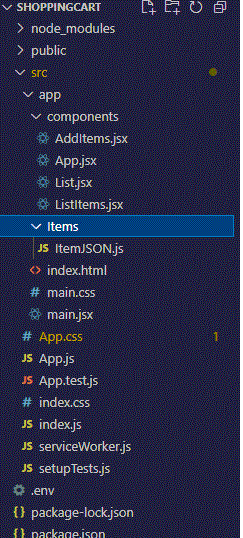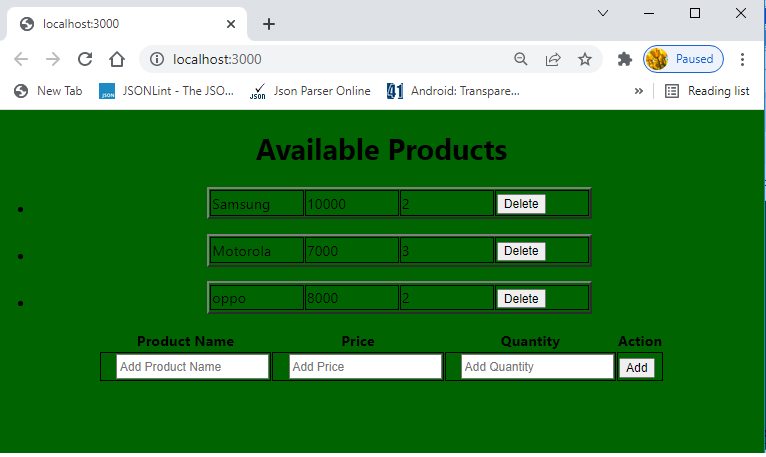Veamos una aplicación de carrito de compras que usa JSX como interfaz. Es una sintaxis similar a XML/HTML ampliamente utilizada por React que amplía ECMAScript y, por lo tanto, el texto similar a XML/HTML también se puede aplicar con código JavaScript/React.
Creación de la aplicación React e instalación de módulos:
Paso 1: Cree la aplicación de reacción usando
npx create-react-app <your foldername> Eg: npx create-react-app shoppingcart
Paso 2: Mover a la carpeta
cd shoppingcart
Paso 3: Instala las dependencias requeridas
npm install @babel/core npm i babel-runtime#Here i stands for install npm i @testing-library/jest-dom npm i @testing-library/react npm i @testing-library/user-event npm i autoprefixer npm i enzyme npm i enzyme-adapter-react-16 npm i react npm i react-dom npm i react-scripts
O, en lugar de hacerlo uno por uno, podemos especificar todo dentro del paquete.json como se indica a continuación y desde el símbolo del sistema podemos dar como:
npm install
Se encargará de instalar todos los paquetes que se mencionaron dentro de las dependencias. Los paquetes que se usaron se pueden verificar desde package.json:
paquete.json
{
"name": "shoppingcart",
"version": "1.0.0",
"description": "shoppingcart",
"main": "app/main.jsx",
"scripts": {
"lint": "eslint 'app/**/*.@(js|jsx)'",
"test": "react-scripts test",
"start": "react-scripts start",
"build": "react-scripts build",
"eject": "react-scripts eject"
},
"dependencies": {
"babel-runtime": "~6.2.0",
"@testing-library/jest-dom": "^4.2.4",
"@testing-library/react": "^9.5.0",
"@testing-library/user-event": "^7.2.1",
"autoprefixer": "^9.8.0",
"enzyme": "^3.11.0",
"enzyme-adapter-react-16": "^1.15.5",
"react": "^16.14.0",
"react-dom": "^16.14.0",
"react-scripts": "3.4.3"
},
"eslintConfig": {
"extends": "react-app"
},
"browserslist": {
"production": [
">0.2%",
"not dead",
"not op_mini all"
],
"development": [
"last 1 chrome version",
"last 1 firefox version",
"last 1 safari version"
]
},
"keywords": [
"react",
"test",
"enzyme"
],
"pre-commit": [
"lint"
],
"devDependencies": {
"babel-eslint": "~4.1.6",
"chai": "^3.4.1",
"html-webpack-plugin": "^5.3.2",
"react-addons-test-utils": "^15.4.1",
"webpack": "^5.55.1",
"webpack-cli": "^4.8.0",
"webpack-dev-server": "^4.3.0",
"jsdom": "^7.2.2"
}
}
Estructura de la carpeta del proyecto: El proyecto debería verse así:

Ejemplo: Comencemos el proyecto:
App.js
import React from 'react';
import './App.css';
// That means it is referring the jsx file
// present under src/app/components folder
import App1 from './app/components/App';
function App() {
return (
<div className="App">
<App1 />
</div>
);
}
export default App;
App.css: para el embellecimiento del proyecto
App.css
.App {
text-align: center;
}
.App-logo {
height: 40vmin;
pointer-events: none;
}
@media (prefers-reduced-motion: no-preference) {
.App-logo {
animation: App-logo-spin infinite 20s linear;
}
}
.App-header {
background-color: #282c34;
min-height: 100vh;
display: flex;
flex-direction: column;
align-items: center;
justify-content: center;
font-size: calc(10px + 2vmin);
color: white;
}
.App-link {
color: #006400;
}
@keyframes App-logo-spin {
from {
transform: rotate(0deg);
}
to {
transform: rotate(360deg);
}
}
.main-wrapper {
display: flex;
justify-content: center;
}
table {
margin: 1rem;
}
table th td,
table tr td {
border: 1px solid black;
border-collapse: collapse;
}
form {
margin: 1rem;
}
input {
line-height: 1.4rem;
margin-left: 1rem;
}
h5 {
display: block;
}
form button {
line-height: 1.4rem;
background-color: #ffffff;
cursor: pointer;
}
.cities-wrapper {
border: 1px solid black;
margin: 1rem;
padding: 1rem;
align-items: flex-end;
height: fit-content;
}
ul {
float: center;
margin-top: 0;
}
.center {
margin-left: auto;
margin-right: auto;
}
.shelf-wrapper {
text-align: left;
display: flex;
justify-content: center;
}
.shelf-wrapper h4 {
text-align: center;
}
.shelf-wrapper .shelf {
width: 19%;
border: 1px solid black;
display: inline-block;
min-height: 15rem;
}
.shelf span {
/* width: 60%; */
}
.shelf button {
float: right;
/* width: 40%; */
}
.book-wrapper span {
width: 100%;
}
.shelf table tr td {
border: none;
}
ItemJSON.js: como este proyecto no involucra ninguna base de datos, deje que los elementos se seleccionen de «ItemJSON.js». Está bajo src >> aplicación >> Elementos >> ItemJSON.js
ItemJSON.js
import { EventEmitter } from 'events';
import assign from 'object-assign';
// Initially specifying the constant items just as an sample
const ProductStore = assign({}, EventEmitter.prototype, {
items: {
products: [
{ productId: 0, productName: 'Samsung',
productPrice: 10000, productQuantity: 2 },
{ productId: 1, productName: 'Motorola',
productPrice: 7000, productQuantity: 3 },
{ productId: 2, productName: 'Redmi',
productPrice: 8000, productQuantity: 4 },
]
},
nextproductId: 3,
// To get all the items and display in the screen
getAll: function getAll() {
return this.items;
},
emitChange: function emitChange() {
this.emit('change');
},
// When an item is added
addChangeListener: function addChangeListener(callback) {
this.on('change', callback);
},
// When an item is removed
removeChangeListener: function removeChangeListener(callback) {
this.removeListener('change', callback);
},
addNewProducts: function addNewProducts(product) {
const products = this.items.products;
if (!products ||
typeof this.items.products.length !== 'number') {
this.items.products = [];
}
product.productId = this.nextproductId++;
product.done = false;
this.items.products.push(product);
},
deleteProducts: function deleteProducts(productId) {
this.items.products = this.items.products.filter(
(product) => product.productId !== productId);
}
});
export default ProductStore;
Inicie la aplicación: escriba el siguiente comando para iniciar la aplicación. El proyecto se inicia en el puerto 3000
npm start
Producción:

A continuación, el código requerido se puede encontrar en App.jsx
App.jsx
import React from 'react';
import AddItems from './AddItems';
import List from './List';
export default class App extends React.Component {
render() {
return (
<div>
<h1>Available Products</h1>
// List.jsx is enclosed
<List />
<AddItems.jsx is enclosed
<AddItems />
</div>
);
}
}
List.jsx: tenemos la opción de agregar los elementos y eliminarlos
List.jsx
import React from 'react';
import ItemJSON from '../Items/ItemJSON';
import ListItems from './ListItems';
export default class ProductList extends React.Component {
constructor(props) {
super(props);
this.state = ItemJSON.getAll();
}
componentDidMount() {
ItemJSON.addChangeListener(this._onChange.bind(this));
}
componentWillUnmount() {
ItemJSON.removeChangeListener(this._onChange.bind(this));
}
_onChange() {
this.setState(ItemJSON.getAll());
}
render() {
const ListItemsList = this.state.products.map(
product => {
return (
<ListItems key={product.productId}
product={product} />
);
});
return (
<center>
// All the items present in
// ItemJSON.js is displayed here
<ul>{ListItemsList}</ul>
</center>
);
}
}
Producción:

Al ingresar los detalles del producto y hacer clic en el botón «agregar», se produce la siguiente funcionalidad:
Javascript
import React from 'react';
import ItemJSON from '../Items/ItemJSON';
export default class AddItems extends React.Component {
//will pick the added product and added
addItems() {
const newProductName = this.refs.product.value;
const newPrice = this.refs.price.value;
const newQuantity = this.refs.quantity.value;
if (newProductName) {
ItemJSON.addNewProducts({
productName: newProductName,
productPrice: newPrice,
productQuantity: newQuantity
});
ItemJSON.emitChange();
this.refs.product.value = '';
this.refs.price.value = '';
this.refs.quantity.value = '';
}
}
render() {
return (
<center>
<div className="add-todo">
<table >
<thead>
<tr>
<th>Product Name</th>
<th>Price</th>
<th>Quantity</th>
<th>Action</th>
</tr>
</thead>
<tbody>
<tr>
<td><input type="text"
placeholder="Add Product Name"
ref="product" /></td>
<td><input type="text"
placeholder="Add Price"
ref="price" /></td>
<td><input type="text"
placeholder="Add Quantity"
ref="quantity" /></td>
<td><button className="add-button"
onClick={this.addItems.bind(this)}>
Add
</button></td>
</tr>
</tbody>
</table>
</div>
</center>
);
}
}
eliminación de un producto: Intentemos eliminar Redmi de la lista anterior. El código requerido para hacer la eliminación está en ListItems.jsx
ListItems.jsx
import React from 'react';
import ItemJSON from '../Items/ItemJSON';
export default class ListItems extends React.Component {
// This code is meant for deletion
deleteProduct(e) {
e.preventDefault();
ItemJSON.deleteProducts(this.props.product.productId);
ItemJSON.emitChange();
}
render() {
const product = this.props.product;
return (
// displaying available products and it
// is having delete action
<li>
<table border="3">
<tbody>
<tr>
<td width="100px">
<span className={`todo-text`} >
{product.productName} </span>
</td>
<td width="100px"><span
className={`todo-text`}>
{product.productPrice}</span>
</td>
<td width="100px"><span
className={`todo-text`}>
{product.productQuantity}</span>
</td>
<td width="100px"><button
className="delete"
onClick={this.deleteProduct.bind(this)}>
Delete </button>
</td>
</tr>
</tbody>
</table>
</li>
);
}
}
Producción:

Podemos probar la funcionalidad del proyecto de la siguiente manera:
App.test.js
import React from 'react';
import Adapter from 'enzyme-adapter-react-16';
import { expect } from 'chai';
import { shallow, mount, configure } from 'enzyme';
import TestUtils from 'react-dom/test-utils';
import App from './app/components/App';
import jsdom from 'jsdom';
import { findDOMNode } from 'react-dom';
configure({ adapter: new Adapter() });
beforeAll(() => {
global.fetch = jest.fn();
// window.fetch = jest.fn(); if running browser environment
});
let wrapper;
beforeEach(() => {
wrapper = shallow(< App />, { disableLifecycleMethods: true });
});
afterEach(() => {
wrapper.unmount();
});
if (typeof document === 'undefined') {
global.document = jsdom.jsdom(
'<!doctype html><html><body></body></html>');
global.window = document.defaultView;
global.navigator = global.window.navigator;
}
describe('DOM Rendering', function () {
it('Add functionality to add new products
by clicking add', function () {
const app = TestUtils.renderIntoDocument(<App />);
const appDOM = findDOMNode(app);
let productItemsLength =
appDOM.querySelectorAll('.todo-text').length;
let addInput = appDOM.querySelector('input');
addInput.value = 'Add item';
let addButton = appDOM.querySelector('.add-todo button');
TestUtils.Simulate.click(addButton);
console.log(appDOM.querySelectorAll('.todo-text').length);
expect(appDOM.querySelectorAll('.todo-text')
.length).to.be.equal(productItemsLength + 3);
// As after adding we will get additional value 3.
});
});
describe('DOM Rendering', function () {
it('On deleting, the item should get deleted', function () {
const app = TestUtils.renderIntoDocument(<App />);
let productItems = TestUtils
.scryRenderedDOMComponentsWithTag(app, 'li');
let productLength = productItems.length;
let deleteButton = productItems[0]
.querySelector('button');
TestUtils.Simulate.click(deleteButton);
let productItemsAfterClick = TestUtils
.scryRenderedDOMComponentsWithTag(app, 'li');
expect(productItemsAfterClick.length)
.to.equal(productLength - 1);
});
});
describe('Enzyme Shallow', function () {
it('App\'s title should be Available Products', function () {
let app = shallow(<App />);
expect(app.find('h1').text())
.to.equal('Available Products');
});
});
describe('Enzyme Mount', function () {
it('Delete An Item', function () {
let app = mount(<App />);
let itemLength = app.find('li').length;
app.find('button.delete').at(0).simulate('click');
expect(app.find('li').length).to.equal(itemLength - 1);
});
});
El script de prueba se puede probar de la siguiente manera:
npm test
Producción:

Publicación traducida automáticamente
Artículo escrito por priyarajtt y traducido por Barcelona Geeks. The original can be accessed here. Licence: CCBY-SA